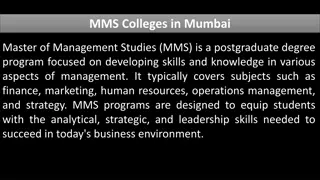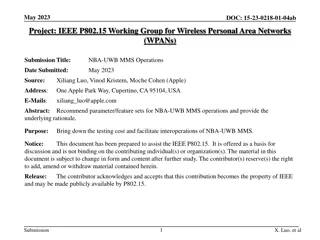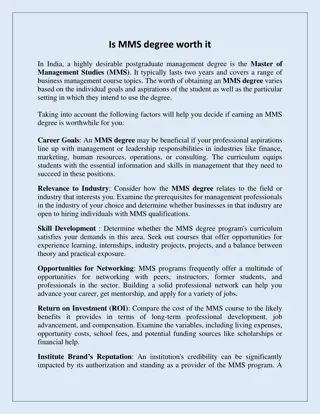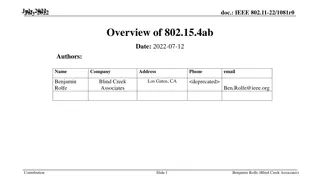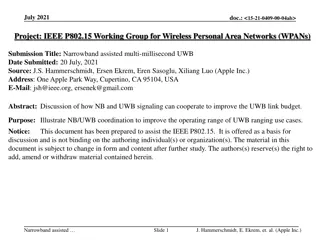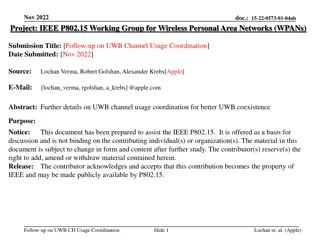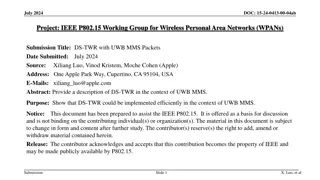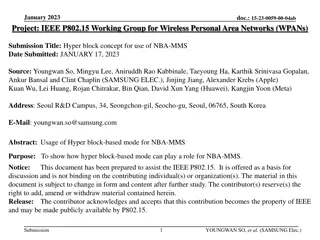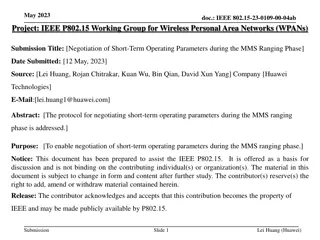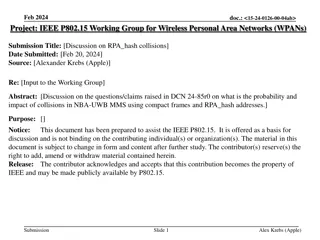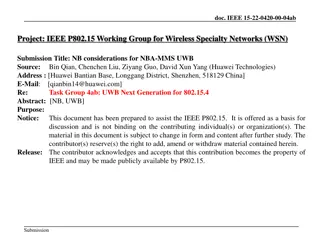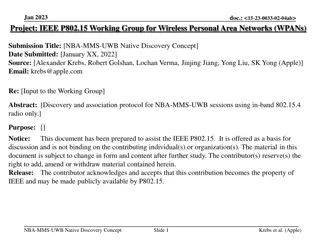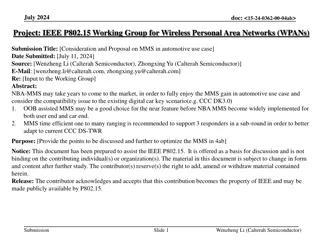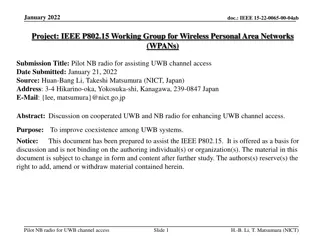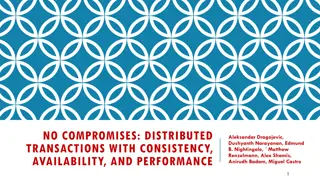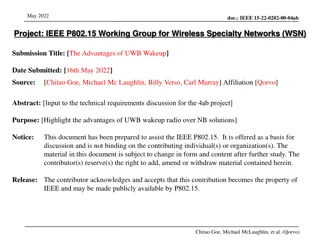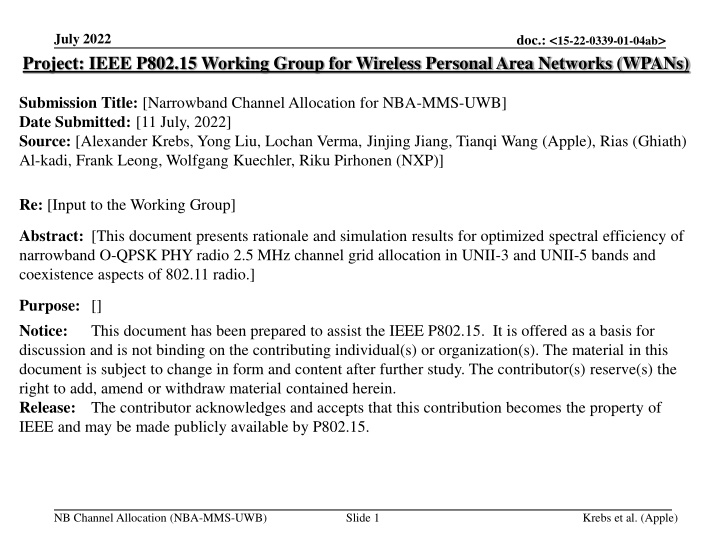
Narrowband Channel Allocation for NBA-MMS-UWB
This document presents optimized spectral efficiency of narrowband O-QPSK PHY radio in 2.5 MHz channel grid allocation for UNII-3 and UNII-5 bands. It discusses coexistence aspects of 802.11 radio and proposes solutions for interference mitigation, high-integrity ranging, reduced complexity, and more.
Download Presentation

Please find below an Image/Link to download the presentation.
The content on the website is provided AS IS for your information and personal use only. It may not be sold, licensed, or shared on other websites without obtaining consent from the author. If you encounter any issues during the download, it is possible that the publisher has removed the file from their server.
You are allowed to download the files provided on this website for personal or commercial use, subject to the condition that they are used lawfully. All files are the property of their respective owners.
The content on the website is provided AS IS for your information and personal use only. It may not be sold, licensed, or shared on other websites without obtaining consent from the author.
E N D
Presentation Transcript
July 2022 doc.: <15-22-0339-01-04ab> Project: IEEE P802.15 Working Group for Wireless Personal Area Networks (WPANs) Submission Title: [Narrowband Channel Allocation for NBA-MMS-UWB] Date Submitted: [11 July, 2022] Source: [Alexander Krebs, Yong Liu, Lochan Verma, Jinjing Jiang, Tianqi Wang (Apple), Rias (Ghiath) Al-kadi, Frank Leong, Wolfgang Kuechler, Riku Pirhonen (NXP)] Re: [Input to the Working Group] Abstract: [This document presents rationale and simulation results for optimized spectral efficiency of narrowband O-QPSK PHY radio 2.5 MHz channel grid allocation in UNII-3 and UNII-5 bands and coexistence aspects of 802.11 radio.] Purpose: [] Notice: discussion and is not binding on the contributing individual(s) or organization(s). The material in this document is subject to change in form and content after further study. The contributor(s) reserve(s) the right to add, amend or withdraw material contained herein. Release: The contributor acknowledges and accepts that this contribution becomes the property of IEEE and may be made publicly available by P802.15. This document has been prepared to assist the IEEE P802.15. It is offered as a basis for NB Channel Allocation (NBA-MMS-UWB) Slide 1 Krebs et al. (Apple)
July 2022 doc.: <15-22-0339-01-04ab> PAR Objective Safeguards so that the high throughput data use cases will not cause significant disruption to low duty-cycle ranging use cases Interference mitigation techniques to support higher density and higher traffic use cases Other coexistence improvement Backward compatibility with enhanced ranging capable devices (ERDEVs) Improved link budget and/or reduced air-time Proposed Solution (how addressed) O-QPSK occupied bandwidth based channel spacing optimization for spectral efficiency Allocation band map of NB channels in UNII-3/5 Additional channels and operating frequencies Improvements to accuracy / precision / reliability and interoperability for high-integrity ranging Reduced complexity and power consumption Hybrid operation with narrowband signaling to assist UWB Enhanced native discovery and connection setup mechanisms Sensing capabilities to support presence detection and environment mapping Low-power low-latency streaming Higher data-rate streaming allowing at least 50 Mbit/s of throughput Support for peer-to-peer, peer-to-multi-peer, and station-to- infrastructure protocols Infrastructure synchronization mechanisms This describes the NB part NB Channel Allocation (NBA-MMS-UWB) Slide 2 Krebs et al. (Apple)
July 2022 doc.: <15-22-0339-01-04ab> NBA-MMS-UWB Narrowband Assisted Multi-Millisecond Ultra-Wideband mission statement Improve link budget of 802.15.4a-z HRP UWB ranging, and ERDEV use cases Assist UWB by offloading data and synchronization packets to narrowband (NB) radio channel Split UWB ranging packets into 2, or more fragments to increase sensitivity through RX aggregation NB Channel Allocation (NBA-MMS-UWB) Slide 3 Krebs et al. (Apple)
July 2022 doc.: <15-22-0339-01-04ab> NB O-QPSK Spectrum Legacy 802.15.4 O-QPSK [1] channel allocation is not optimized O-QPSK 99% occupied bandwidth (OBW) [2] less than 2.4 MHz Below graphs compare 802.15.4 O-QPSK vs BLE 2M GMSK PHY (dashed line) Notably, BLE uses 2 MHz spacing, whereas legacy O-QPSK uses 5 MHz 0 0 802.15.4 O-QPSK BLE GMSK 2M 802.15.4 O-QPSK BLE GMSK 2M Normalized energy outside channel [dB] -5 -10 -10 OBW < 2.4 MHz -15 Attenuation [dBc] -20 -20 -30 -25 OBW > 2 MHz -30 -40 -35 -50 -40 -45 -60 -50 -4 -3 -2 -1 0 1 2 3 4 0 1 2 3 4 5 6 106 f [Hz] 106 Channel bandwidth [Hz] NB Channel Allocation (NBA-MMS-UWB) Slide 4 Krebs et al. (Apple)
July 2022 doc.: <15-22-0339-01-04ab> NB Channels 2.5 MHz channel spacing results in 250 channels in aggregated UNII-3+5 (~229 permitted in most regions world wide) Center frequencies we investigate currently (aligned vs. unaligned with 802.11 borders) Aligned Unaligned NB Channel Allocation (NBA-MMS-UWB) Slide 5 Krebs et al. (Apple)
July 2022 doc.: <15-22-0339-01-04ab> NB Performance 1/2 Simulation parameters K Tx-Rx pairs randomly placed in 100m x 100m square, isotropic ant., P_out=10dBm Randomly selected channels within 125 MHz of total BW, 10 byte PSDU, B2B packets ACI via sum of FSPLs at 5.8GHz, PER via inverse SINR waterfall curves from [3] 12 2.5 MHz, O-QPSK 250 Kbps 5 MHz, O-QPSK 250 Kbps 10 Total network throughput [Mbit/s] +94% 8 6 4 2 0 10 20 30 K = number of Tx-Rx pairs 40 50 100 200 300 500 Data Rate = 250kbps: Preamble length = 128us, SFD length = 32us, PHR length = 32us, Payload length = 320us, Total packet duration: 512us NB Channel Allocation (NBA-MMS-UWB) Slide 6 Krebs et al. (Apple)
July 2022 doc.: <15-22-0339-01-04ab> NB Performance 2/2 Additional O-QPSK modes proposed in [4] 15 Maximum total network throughput [Mbit/s] Data Rate = 500kbps Note both PHR and the payload go through the rate-1/2 convolutional code with generator polynomials (133, 171) as specified in Clause 21.3.6 of IEEE 802.15.4-2020 or in Clause 15.3.3 of IEEE 802.15.4z-2020 Preamble length = 64us SFD length = 32us PHR length = 28us Payload length = 172us PHR carries (8+6)x2 = 28 coded bits Payload carrier (80+6)x2 = 172 coded bits Total packet duration: 296us 10 5 Data Rate = 1000kbps Preamble length = 64us SFD length = 32us PHR length = 8us Payload length = 80us Total packet duration: 184us 0 1 2 3 250 kbps 500 kbps 1000 kbps 5 MHz 2.5 MHz NB Channel Allocation (NBA-MMS-UWB) Slide 7 Krebs et al. (Apple)
July 2022 doc.: <15-22-0339-01-04ab> Summary Given the analyzed spectral properties of 802.15.4 O-QPSK modulation, we propose allocation by a start of 250 NB channels in UNII-3 and UNII-5 bands with channel spacing of 2.5 MHz, in order to increase spectral efficiency over the 5 MHz channel spacing used in legacy 802.15.4 at 2.4 GHz. Simulations results show potential for increase in maximum network throughput for the legacy 250kpbs O-QPSK PHY, as well as the newly proposed 500 kbps CC r=1/2 K=7, and uncoded 1 Mbps modes, over both low and high density deployment use cases. The proposed channel spacing targets current and prospected regulatory requirements in most regions world wide, under particular consideration of the occupied bandwidth criteria from ETSI and guard band requirements from FCC. NB Channel Allocation (NBA-MMS-UWB) Slide 8 Krebs et al. (Apple)
July 2022 doc.: <15-22-0339-01-04ab> References [1] IEEE 802.15.4-2020 Standard for Low-Rate Wireless Networks , LAN/MAN Standards Working Group. [2] 6 GHz WAS/RLAN; Harmonised Standard for access to radio spectrum , Draft ETSI EN 303 687 V1.0.0, April 2022. [3] S. Lanzisera and K. S. J. Pister, "Theoretical and Practical Limits to Sensitivity in IEEE 802.15.4 Receivers 14th IEEE International Conference on Electronics, Circuits and Systems, 2007, pp. 1344-1347. [4] X. Luo (Apple Inc), F. Leong (NXP), M. Lee (Samsung Electronics), et al., NBA-UWB Technical Framework Proposal , 15-22-0262-01-004ab, May 2022. NB Channel Allocation (NBA-MMS-UWB) Slide 9 Krebs et al. (Apple)

